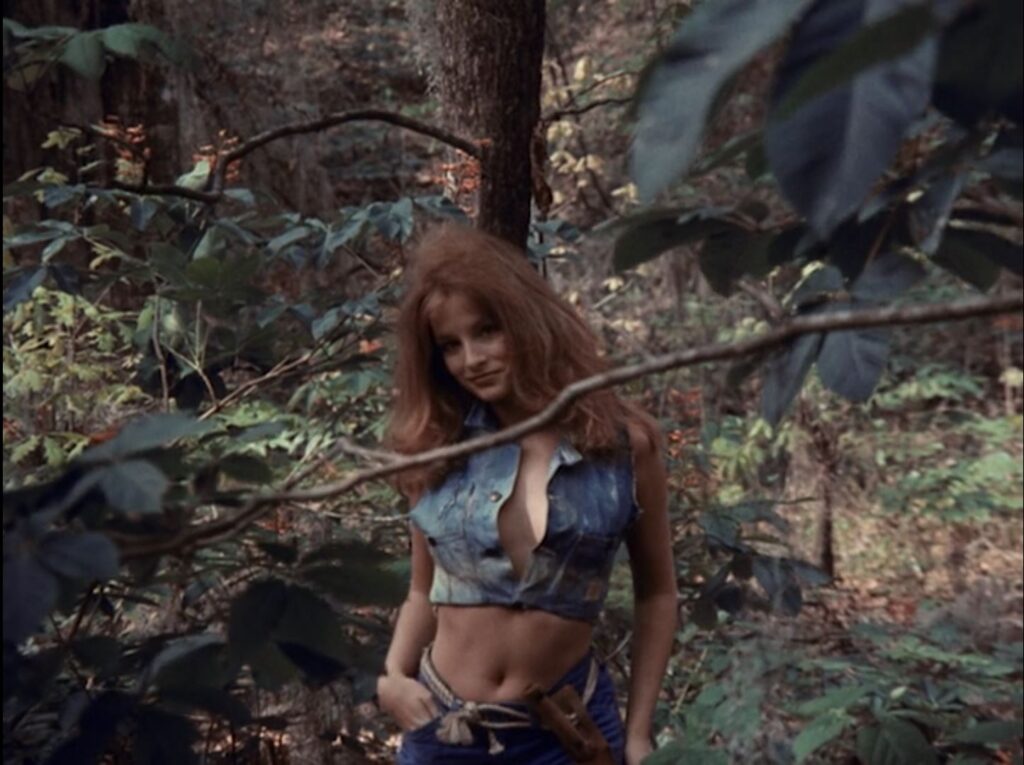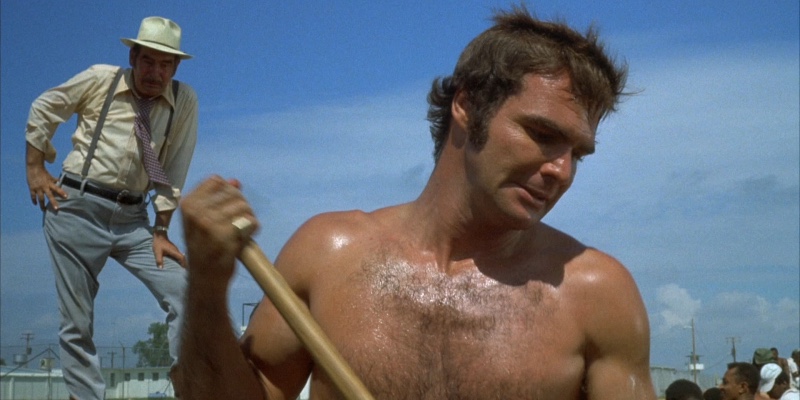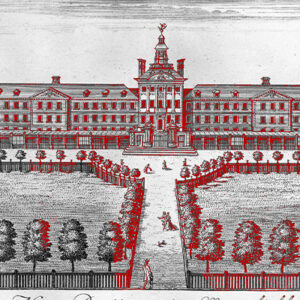The 1970s was an odd decade for movies. Following the late 1960s counterculture movement and consciousness-raising that translated into films like 1969’s “Easy Rider,” the 1970s were a time of great artistic merit, as exemplified by the “Godfather” films, huge box-office blockbusters like “Jaws” and “Star Wars,” and a steady stream of drive-in fare best represented by horror films and so-called “blaxploitation” films.
And then there were the Southern-fried, often-seedy but always entertaining crime films set in redneck towns surrounded by swamps and crossed only by lonely highways. These were the kind of movies you were lucky to find at a drive-in double feature with a Roger Corman film – many of them were Corman films – and they were successful enough to spawn many other films, some of which, like “Smokey and the Bandit,” were big box-office hits. Because they were so cheaply produced, they made a lot of money, but their sometimes-unsavory marketing or word of mouth made them an under-the-radar guilty pleasure.
The Southern-fried drive-in flicks even influenced the James Bond movies. (I’ll explain, I promise.)
There’s been a current of Southern ennui, malaise and corruption in novels, TV and movies for as long as there’s been a Southern United States. On TV, Andy Griffith’s Andy Taylor was the exception to all those stories about corrupt Southern lawmen, but his North Carolina town was filled with colorful characters, oddballs, town drunks and folks from the hills who got liquored up and started playing banjo or throwing rocks. (Imagine if Andy had taken a hard line with those offenders? That’s a whole different kind of show.)
The Clampetts, who moved to the Hills of Beverly, popularized the hick stereotypes, as did the soda pop Mountain Dew, which was born not far from me here in Knoxville and was once labeled with a hillbilly drinking from a jug.
One of the best known, relatively early big-screen treatments of Southern crime and corruption came in 1958 with “Thunder Road,” starring Robert Mitchum as a moonshine runner. With a little luck and a strong tailwind, I can throw a Mountain Dew bottle from where I am right now and hit the original Thunder Road.
I feel this Southern entertainment streak acutely, obviously.
As a newspaper reporter for decades, I covered Indiana politicians who were only slightly less charismatic but just as corrupt as Willie Stark, whose exploits were first recounted in Robert Penn Warren’s Pulitzer-winning novel “All the King’s Men.” The 1949 film version featured Broderick Crawford as Stark and is a template for later Southern corruption films, as is “Thunder Road.”
In the late 1960s and throughout the 1970s, those templates, archetypes and a few others I’ll detail here were used to solidify the idea, for moviegoers around the world, that the South was a fetid, corrupt and dangerous place. Sometimes those ideas were accurate, but usually not. But they sure sold tickets.
The good ol’ boy who hits hard
There is no better example of the Southern good ol’ boy in movies than Burt Reynolds, who hailed from Florida, made a living in Hollywood and then came to represent the rowdy Southern boy cliché like no one else.
Reynolds made his mark in westerns and crime dramas for movie and TV before striking gold in 1972 with “Deliverance,” director John Boorman’s film version of the James Dickey novel. Reynolds played one of four men lost in the Georgia backwoods who, when hunted, become as murderous as their hillbilly adversaries. The unsettling banjo scene and the threat of male rape were used to make the film as off-putting and terrifying to modern audiences as possible. “Deliverance” launched Reynolds’ film career.
“White Lightning” followed in 1973, along with its sequel, “Gator,” in 1976. Reynolds played other roles, from tough cops to comedic and romantic leads, but it was those three movies that not only solidified his stardom but led to his casting in “Smokey and the Bandit” in 1977.
As Bobby “Gator” McKluskey in “White Lightning” and “Gator,” Reynolds was not just a good ol’ boy but the archetype Southern avenging angel. In the first film, he’s in an Arkansas prison for running moonshine but escapes when he hears his younger brother has been killed by evil sheriff J.C. Connors, played by Ned Beatty, Reynolds’ “Deliverance” co-star.
The “Gator” films – the second directed by Reynolds – have some Southern comedy but they’re thick with atmosphere and crime: not just moonshine but corrupt and evil sheriffs and politicians as well as drugs, prostitution and murder.
By comparison, “Smokey and the Bandit” is a movie made for a children’s matinee.
The Southern girl who fights back
If there was a woman in 1970s cinema who was the feminine equal of Reynolds, it was probably Pam Grier, whose beauty kept some from recognizing her steely determination.
But for the Southern-fried version of Grier, look no further than Claudia Jennings. A lot of women in exploitation films of the 1970s were either victims or objects of desire, but some could kick ass. Grier sure could in films aimed at the urban box office. Jennings was an object of desire and an avenger like Reynolds, and she was most memorable in films steeped in Southern sweat and swamps.
Jennings was Playboy’s playmate of the year in 1970, after having worked in the Playboy offices, and no doubt her work for the magazine taught her how to navigate treacherous waters. She broke out as the lead in the roller derby drama “Unholy Rollers” in 1972 and “Truck Stop Women” in 1974 and took a few roles in comedies until making her place in drive-in history in 1974 with “’Gator Bait.”
 Gator Bait (1973)
Gator Bait (1973)
Following in the wake of “White Lightning” but in advance of “Gator,” “’Gator Bait” was cheap and looks it. Jennings, as a barely-dressed swamp dweller named Desiree Thibodeau, is a poacher of alligators. That makes her a target for Sheriff Joe Bob and his son, a deputy named Billy Boy. But when men led by Tracy Sebastian as Big T victimize Desiree’s family, Desiree aims for revenge – and gets it.
(Desiree was called “’Gator Bait” in the movie, by the way, because her father, also an alligator poacher, tied a rope around young Desiree and threw her into the swamp to attract gators. And you think your parents were tough on you.)
Jennings made impressions with moviegoers in “Moonshine County Express” in 1977 and the Roger Corman-produced sci-fi film “Deathsport” in 1978. She had a part in “The Man Who Fell to Earth,” but one of my favorites of her films was “The Great Texas Dynamite Chase,” released in 1976.
A film that “Thelma and Louise” owes a debt to, “The Great Texas Dynamite Chase” stars Jennings as Candy and Jocelyn Jones as Ellie-Jo. Candy breaks out of prison and armed with some aging and faulty sticks of dynamite, robs a bank. Ellie-Jo, a teller, decides to join her and the two, Bonnie and Bonnie style, travel around the state, robbing banks simply by lighting the fuse on a stick of dynamite. The dynamite often fizzles. Sometimes it does not, and neither does the movie.
The film reinforces that the two women can’t trust (most) men and can rely only on each other. It’s almost a remake of “Butch Cassidy and the Sundance Kid,” although with a happier ending.
Jennings’ death in 1979 at only 29 years old cut short not only her life but a promising career. I would have loved to have seen her in the type of latter-day roles that Grier filled, and I would have loved to have seen a bank-robbing reunion of 50-something Candy and Ellie-Jo. It was not to be.
Sidekicks were along for the wild ride
A few other women had an impact in Southern crime films in the 1970s – Angie Dickinson as the mother of two rowdy young women in “Big Bad Mama” comes to mind – and Dickinson got some support on screen from her sidekicks, played by Tom Skerritt and William Shatner.
That film demonstrated that sidekicks could transform into adversaries, but with no disrespect to Shatner and Skerritt, no one played a better sidekick than singer, songwriter and actor Jerry Reed.
Reed had a role in the 1975 comedy “W.W. and the Dixie Dancekings,” which starred Reynolds and was directed by John G Avildsen, a year before Avildsen made “Rocky.” The chemistry between Reynolds and Reed clicked and when Reynolds directed “Gator” he asked Reed to join the cast.
A year later, Reed would play Cledus, Reynolds’ sidekick, in “Smokey and the Bandit” and its sequel and Reed moved into the lead role in the third film in the series, which featured Reynolds in a cameo.
Reed had the country chops not only for the music industry but for films. He went on to play himself or thinly-disguised versions of himself for the rest of his Hollywood career.
He was never more amiably chilling, though, than in “Gator.” Reed played “Bama” McCall, an old friend of Gator’s who has become the crime boss of a small Georgia town. Gator is used by federal authorities to take down Bama’s empire of drugs and prostitution, but Gator is motivated to bring down his friend’s empire after he’s horrified by the underage prostitutes at Bama’s place. “Gator” isn’t as good a film as “White Lightning,” and that’s partly because the sequel lacked one of the strongest elements of the original: Beatty as a ruthless lawman.
The long, corrupt arm of the law – and a few good lawmen
The TV series “The Dukes of Hazzard” debuted in 1979 and co-opted many of the themes of Southern crime movies, namely the good ol’ boys, the booty-shorts-wearing female lead and the corrupt town boss and sheriff. The show took all the menace out of the latter characters, of course.
By the close of the 1970s, it would have been hard to make those corrupt lawmen really stand out. By that point, we’d seen all kinds of southern badge-wearers.
 Macon County Line (1974)
Macon County Line (1974)
In 1974’s “Macon County Line,” we saw a Clampett – Jethro Bodine himself, Max Baer Jr. – as a menacing deputy who, after the film ambles along for an hour, decides the three leads are responsible for his wife’s death and seeks revenge.
In a comedic vein, the “Smokey and the Bandit” films gave us Jackie Gleason as Sheriff Buford T. Justice, who upped the film’s comedic quotient with his inept efforts to catch Reynolds, Reed et al.
We saw incorruptible lawmen like the great Ben Johnson as J.D. Morales, a legendary investigator with the Texas Rangers in “The Town That Dreaded Sundown,” a pseudo-documentary about the hunt for a serial killer in 1940s Texarkana, Texas. Johnson is great, as always, as the drawling, matter-of-fact lawman.
Released in 1970, “tick … tick … tick” gave us former football great Jim Brown as the first Black sheriff of a small Southern town. When lawlessness threatens the peace, the cop gets an assist from the previous sheriff, played by George Kennedy.
Probably the most famous real-life lawman portrayed in films of the 1970s and beyond was Buford Pusser, a county sheriff in Tennessee who carried a two-by-four and tried to clean up the Dixie Mafia and its domain of drugs, prostitution and gambling on the Mississippi state line. Pusser, who survived assassination attempts only to die in a 1974 car crash, was the inspiration for a series of movies that began in 1973 with “Walking Tall.”
But the most memorable lawman in Southern-fried 1970s flicks had to have been Ned Beatty as J.C. Connors, whose killing of Gator McClusky’s kid brother kicks off the plot of “White Lightning.” Beatty is the personification of small-town evil in the role. Despite his too-tight, short-sleeve shirt and his pocket protector and his rants about hippies and communists, we take him seriously because Reynolds’ Gator takes him deadly seriously.
Oh, and how did the Southern movies of the 1970s work their way into films about James Bond, the quintessential British spy with the license to kill?
Well, it’s not like Southern sheriffs weren’t a cliché before all these Southern-fried crime films started coming out around 1970, but the producers of the Bond films saw an opportunity to include a Southern sheriff, J. W. Pepper, played by Clifton James, in “Live and Let Die” in 1973. Pepper was comic relief, not unlike the blustering Buford Justice played by Jackie Gleason in the “Smokey and the Bandit” movies.
Audiences no doubt found Sheriff Pepper jarring in the Bond film, even though it was set in the South. Bond fans were either amused, irritated or confused when James returned as Pepper in “The Man with the Golden Gun” in 1974. The sheriff and his wife took a trip to Thailand and ran into Bond there.
And that was probably as far afield as any 1970s Southern movie lawman strayed from his jurisdiction.

















